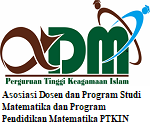Binary Cyclic Pearson Codes
DOI:
https://doi.org/10.15642/mantik.2021.7.1.1-8Keywords:
Pearson distance, Pearson code, Cyclic codeAbstract
The phenomena of unknown gain or offset on communication systems and modern storages such as optical data storage and non-volatile memory (flash) becomes a serious problem. This problem can be handled by Pearson distance applied to the detector because it offers immunity to gain and offset mismatch. This distance can only be used for a specific set of codewords, called Pearson codes. An interesting example of Pearson code can be found in T-constrained code class. In this paper, we present binary 2-constrained codes with cyclic property. The construction of this code is adopted from cyclic codes, but it cannot be considered as cyclic codes.
Downloads
References
K. A. S. Immink and J. H. Weber, “Minimum pearson distance detection for multilevel channels with gain and/or offset mismatch,” IEEE Trans. Inf. Theory, vol. 60, no. 10, pp. 5966–5974, 2014, doi: 10.1109/TIT.2014.2342744.
F. Sala, K. A. S. Immink, and L. Dolecek, “Error Control Schemes for Modern Flash Memories,” IEEE Consum. Electron., vol. 4, no. 1, pp. 66–73, 2015.
J. H. Weber, K. A. S. Immink, and S. R. Blackburn, “Pearson codes,” IEEE Trans. Inf. Theory, vol. 62, no. 1, pp. 131–135, 2016, doi: 10.1109/TIT.2015.2490219.
K. A. S. Immink and J. H. Weber, “Hybrid Minimum Pearson and Euclidean Distance Detection,” IEEE Trans. Commun., vol. 63, no. 9, pp. 3290–3298, 2015, doi: 10.1109/TCOMM.2015.2458319.
J. H. Weber, T. G. Swart, and K. A. S. Immink, “Simple systematic Pearson coding,” IEEE Int. Symp. Inf. Theory - Proc., vol. 2016-Augus, pp. 385–389, 2016, doi: 10.1109/ISIT.2016.7541326.
S. A. Vanstone and P. C. Oorschot, An Introduction to Error Correcting Codes with Applications. Springer US, 1989.
S. Ling and C. Xing, Coding Theory. Cambridge University Press, 2004.
A. Betten, M. Braun, H. Fripertinger, A. Kerber, A. Kohnert, and A. Wassermann, Error-Correcting Linear Codes. Springer Berlin Heidelberg, 2006.
K. A. S. Immink, “Coding schemes for multi-level channels with unknown gain and/or offset,” IEEE Int. Symp. Inf. Theory - Proc., pp. 709–713, 2013, doi: 10.1109/ISIT.2013.6620318.
K. A. S. Immink, “Coding schemes for multi-level Flash memories that are intrinsically resistant against unknown gain and/or offset using reference symbols,” Electron. Lett., vol. 50, no. 1, pp. 20–22, 2014, doi: 10.1049/el.2013.3558.
“MAGMA Handbook.” http://magma.maths.usyd.edu.au/magma/handbook/ (accessed Nov. 05, 2018).
Downloads
Published
How to Cite
Issue
Section
License
- Authors retain copyright and grant the journal right of first publication with the work simultaneously licensed under a Creative Commons License that allows others to share the work with an acknowledgment of the work's authorship and initial publication in this journal.
- Authors are able to enter into separate, additional contractual arrangements for the non-exclusive distribution of the journal's published version of the work (e.g., post it to an institutional repository or publish it in a book), with an acknowledgment of its initial publication in this journal.
- Authors are permitted and encouraged to post their work online (e.g., in institutional repositories or on their website) prior to and during the submission process, as it can lead to productive exchanges, as well as earlier and greater citation of published work







.png)




